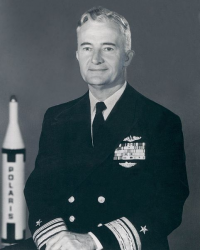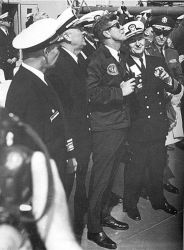
 |
|
|
||
|
Ignatius Joseph Galantin 'Pete' |
||||
|
Graduate, U.S. Naval Academy, Class of 1933 Engagements: • World War II (1941 - 1945)• Korean War (1950 - 1953) |
||||
| Biography: | ||||
|
Ignatius Joseph "Pete" Galantin Admiral, U.S. Navy Ignatius Joseph "Pete" Galantin was born on 24 September 1910 in New York City, NY, the son of Ignatius Peter and Mary Elizabeth Binder Galantin. He attended Maine Township High School, Des Plaines, IL, and had a year of night school at the Armour Institute of Technology in Chicago, before his appointment to the U.S. Naval Academy in 1929. As a Midshipman, he was captain of the fencing team, and in 1933 was intercollegiate champion. Graduated with the class of 1933-A and commissioned Ensign, to rank from 1 June 1933. After graduation from the Naval Academy, he served until December 1935 as a junior watch and division officer on board USS New York (BB-34), operating with Battleship Division ONE, Battle Force. He then had submarine training at the Submarine School, New London, CT, and in July 1936 joined USS Argonaut (SM-1), the largest submarine-minelayer, to serve as First Lieutenant and Gunner Officer in the Hawaiian Islands area. In June 1940, he reported as Executive Officer and Navigator of USS S-24 (SS-129), which was transferred to the British early in the World War II period by lend-lease agreement. World War II In August 1942, he assumed command of the USS R-11 (SS-88). He joined USS Sculpin (SS-191) in June 1943 as Prospective Commanding Officer and participated in one war patrol in the Pacific area. From August 1943 until December 1944, he was in Command of USS Halibut (SS-232), which was awarded the Navy Unit Commendation for her tenth war patrol. He took part in the Battle of Leyte Gulf as Commanding Officer of Halibut, and sank a large Japanese warship off Cape Engamo, P.I. Halibut was so severely damaged by Japanese depth charges that it was not salvageable so the submarine was scrapped. In January-February 1945, he served as Operations and Gunnery Officer on the Staff of Commander Submarine Squadron Ten, then flew over the Hump to Chungking, China, for three months' duty as Submarine Liaison Officer to the Chief of the Naval Group. During the period June-November 1945, he served as Operations and Gunnery Officer on the Staff of Commander Submarine Task Group, Saipan. Post-WWII Upon his return to the U.S. in November 1945, he was ordered to the Staff of Commander Submarines, Atlantic Fleet, and served as Personnel Officer until July 1947. After duty as Executive Officer of USS Proteus (AS-19), a submarine tender, he served as Operations and Gunnery Officer on the Staff of Commander Submarine Squadron Eight. He had Command of Submarine Division Fifty-one in 1949, and in December of that year reported to the Office of the Chief of Naval Operations, Navy Department, Washington, DC, where he served until July 1952 as head of the Submarine Branch, Fleet Maintenance Division. He assumed Command of oiler USS Navasota (AO-106) in August 1952, and was awarded a Letter of Commendation, with Ribbon and Combat "V," for meritorious service. The next year he commanded Submarine Squadron Seven, and from August 1954 to June 1955 was a student at the National War College in Washington. Flag Officer Assignments Upon graduation from the National War College, he was ordered to the Office of the Chief of Naval Operations, Navy Department, where he served for two years as head of the Submarine Warfare Branch, Undersea Warfare Division. He was Deputy Chief of Staff for Logistics and Administration of the Commander in Chief, Allied Forces Southern Europe, stationed in Naples, Italy, from September 1957 until November 1959, then reported as Commander Cruiser Division Two. In January 1961, he became Director of the Antisubmarine/Submarine Warfare Division, Office of the Chief of Naval Operations (later redesignated Submarine Warfare Division). On 26 February 1962 he was assigned as Special Projects Office in the Office of the Secretary of the Navy, Navy Department. On 1 March 1965 he assumed duty as Chief of Naval Material. Upon the reorganization of the Navy Department, effective 1 May 1966, he was designated Chief of Naval Material, Naval Material Command. On 19 May 1967 he was promoted to the four-star rank of Admiral. On 1 July 1970, Admiral Galantin was transferred to the Retired List of the U.S. Navy. Medals and Awards Navy Cross In Retirement Admiral Galantin was a member of the New York Society of Military and Naval Officers of the World Wars. He published two books concerning submarines: Take Her Deep, a more or less autobiographical account of Galantin's wartime action when he was skipper of Halibut, and Submarine Admiral which describes the evolutionary process of the submarine in the U.S. Navy. Personal He was married in 1935 to Virginia E. Jaeckel of New York. They had three daughters, six grandchildren and eight great-grandchildren. Death and Burial Admiral Ignatius Joseph "Pete" Galantin died on 6 July 2004 at the age of 93. He was buried at the U.S. Naval Academy Cemetery in Annapolis, MD. |
||||
| Honoree ID: 519 | Created by: MHOH | |||
Ribbons
Medals
Badges
Honoree Photos
 |  |  |
 |  |
 |


